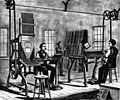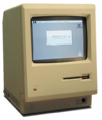Typesetting machine
A typesetting machine is used in the printing industry to describe apparatus or machines for the production of font types using lead type letters or lines. The first developments in this area began with the mechanized arrangement of previously cast metal type letters into complete lines. With further developments, the setting tools were then able to carry out additional processing steps such as B. Accept and file exclude . There have also been attempts with logotypes to accelerate the process.
Beginnings of the typesetting machine
Efforts to replace the slow working method of manual typesetting by machines were encouraged, among other things, by the further development of printing machines. The high- speed press in particular accelerated the printing process considerably. However, there was a lack of a sufficiently fast and flexible typesetting process for the text to be able to meet the increasing demand for printed material. From the middle of the 19th century there were numerous attempts to overcome the bottleneck of the setting process by using machines. Most developments, however, were doomed to fail.
Type setting machine
The first type of machine was called the type setting machine because it used conventional letters made of type metal , as they were also used in hand typesetting. In the type setting machines, the characters to be set were entered using a keyboard or a keyboard . Pressing a button opened the channel to the associated magazine, and a (manual set) type was released. These were collected one after the other at a central point to form a line. The exclusion of the line and the filing after printing were initially carried out by hand; later inventions could do this automatically. The machines were driven by a pedal or steam power; one model also ran on electricity.
Examples of key representatives:
The inventor of the functional principle of the type setting machine is William Church . He received an English patent for his machine in 1822. Here the set lines were taken one by one from the machine and excluded by hand. The problem of tedious manual filing should be avoided through the constant use of new types. The used types should be melted down again. Church had also developed a high-speed casting machine for this purpose.
Christian Sörensen developed the "tacheotype" in 1855. This typesetting machine was the first to work with special letters that were distinguished by differently toothed signatures on the fonts. This allowed the filing to take place automatically. This principle was also taken up again by later inventors, for example with the Linotype typesetting machine .
Charles Kastenbein received an English patent for his typesetting machine in 1869 . Here, too, the lines were excluded by hand. The types had to be handed over by hand to a filing machine that he had also developed.
Charles S. Westcott had developed a machine in 1871 in which a type casting and a setting device were connected, so that the type pressed on the key was cast anew each time, thus avoiding filing completely; However, it could not exclude automatically and therefore worked too slowly, and its mechanism was too complicated. James Paige's machine in 1872 was the first of its kind that could automatically exclude the sentence lines and store the sentence.
John Hooker had built an electric typesetting machine for the Clowes printing company in London in 1877. He replaced the keyboard with small copper plates that were part of an electrical circuit. If the typesetter touched it with a special pen, he closed the circuit and a magnet controlled the release of the type. With the Clowes only smooth sentence without capital letters could be produced; these had to be inserted by hand.
However, the principle of the type setting machine could not prevail because the manual typesetting types were difficult to transport in the machines and usually required manual filing. The writing metal was too soft for machine processing and often got stuck in the machines. Several people were also required to operate a single machine, which greatly reduced the cost savings. When typesetting machines were used, one could only work a little faster with them than with manual typesetting. The process was replaced by machines that could independently re-cast the lines with the help of matrices.
Line setting and casting machine
The functional principle of the line typesetting and casting machines was based on working with matrices instead of hand typesetting . From these a form was put together, which was then poured with liquid lead. The machines were able to automatically exclude the lines beforehand and then transport the dies used back into their magazine independently.
Examples of key representatives:
Ottmar Mergenthaler introduced the most famous line typesetting machine in 1886 with the Linotype typesetting machine . Cast matrices were released from their magazine channels using a keyboard. The individual matrices were collected into a line and excluded to the full line width with space wedges (variable word spacing) before they were cast into a one-piece line in a casting device. After the line was cast, the letter matrices and space wedges were automatically returned to their magazines so that they are available for further use. - The first machine model still used compressed air to transport the die from the die magazine to the line collector; later an endless conveyor belt was used for this die transport. The Linotype typesetting machine was further developed by Mergenthaler and his successors. It was produced until the end of 1976. A competing machine that worked on the same principle and with partly the same components was the Intertype typesetting machine after 1912 , after the patent rights for the Linotype typesetting machine had expired.
The typograph by the American inventor Rogers was first built in 1890. The individual matrices were located here as rods guided on wires in a basket. After the line had been cast, they were brought back to their starting position by tilting the basket. Here, too, a cast line was created from one piece. - A major disadvantage of the Typograph machine (e.g. compared to the Linotype typesetting machine): a subsequent line could only be "set" after the matrices for the last line cast had returned to their starting position.
The monotype by Tolbert Lanston from 1897 also used single matrices, but the system was structured differently and consisted of two units. On the input unit (button) the typesetter created a punched tape , which was then read in on the separate casting machine. This generated a sentence from individual letters, which, in contrast to the other systems, usually enabled corrections without having to recast the entire line.
The matrix system had solved the previous problems with the lead types. The casting machines could be used economically for the first time because they could be operated by a single person. The type performance was around 6,000 to 10,000 characters per hour.
Subsequent machine technology
As a cost-effective method for typesetting the application of was writing typesetting machine . This process existed in parallel with the lead and photo typesetting machines. With typewriters , in contrast to normal typewriters, the text could also be formatted in justification . If the text was typed on special foils, these could serve directly as a printing form.
In the 1950s, photo typesetting began to compete with lead typesetting machines with its new technology. The photo typesetting process exposed u. a. from matrices with embedded letter film negative ( Intertype photo setter, a technological interim solution), from a negative writing disc or plate ( Diatype , Diatronic ) or a negative writing plate (including Linofilm, Linotron ) the characters on light-sensitive photographic material. This typesetting method was also called cold or weightless typesetting, as no typeface metal was used and some mechanical restrictions were eliminated. In phototypesetting, for example, you could continuously change the size of characters without using a different typeface. While the output product of the lead typesetting machines was always a printing form for the letterpress process, a film was created with the photo typesetting, which was used as a printing form in offset printing after its further processing (e.g. assembly to a full page).
The further developed form of the typesetting and the exposure on film with proprietary hardware was the exposure without writing material using cathode ray tubes (CRT) (Hell-Digiset, Linotronic and CRTronic series from Linotype). The font information was available in digital form.
A further development in connection with Linotype photo typesetting machines was the SGT ( typesetting terminal). With the use of the SGT, pages could be created interactively on a screen, similar to what was later used for desktop publishing. These "digital" pages were converted into typesetting commands and transferred on a data carrier to a CRTronic or Linotronic photo setting machine for exposure.
Desktop publishing
Up to the present day, desktop publishing (DTP), which was introduced in 1985, is predominantly used for commercial typesetting . With the use of the page description language PostScript , the appearance of the desktop publishing program PageMaker from Aldus , the desktop computer Apple Macintosh and the Apple LaserWriter , the first PostScript laser printer, the tasks of setting machine took over more and more computers on which a set program or DTP program operated becomes. The typesetting result can be transferred to an external film imagesetter, exposed on printing plates or output directly using the digital printing process.
literature
- Sepp Dußler, Fritz Kolling: Modern typesetting . 4th edition. Verlag Documentation Saur KG, Pullach 1974, ISBN 3-7940-8703-8 .
- Helmut Hiller, Stephan Füssel: Dictionary of the book . 7th edition. Vittorio Klostermann, Frankfurt 2006. ISBN 3-465-03495-3 .
- Richard E. Huss: The Development of Printers' Mechanical Typesetting Methods 1822-1925. University Press, Virginia 1973, ISBN 0-8139-0336-X .
- Manfred Raether: Linotype - Chronicle of a company name . E-book (PDF), Schöneck 2009
- Matthias Otto: The typesetting machine in Germany. Examples of a delayed and low-conflict technology introduction . In: Technikgeschichte, Vol. 60 (1993), H. 4, pp. 347-364.














